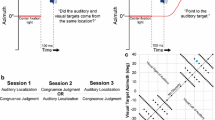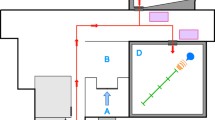Abstract
In the psychophysical phenomenon visual bias, an accurately localized irrelevant signal, such as a light, impairs localization of a spatially discrepant target, such as a sound, when the two stimuli are perceived as unified. Many studies have demonstrated visual bias in azimuth, but none have tested directly or found this effect in depth. The current study was able to produce over 90% bias in azimuth and somewhat less (83%) bias in depth. A maximum likelihood estimate can predict bias by the variance in the localization of each unimodal signal in each dimension in space.













Similar content being viewed by others
References
Agganis BT, Muday JA, Schirillo JA (2010) Visual biasing of auditory localization in azimuth and depth. Perceptual Motor Skills 111:872–892
Alais D, Burr D (2004) The ventriloquist effect results from near-optimal bimodal integration. Curr Biol 14:257–262
Anastasio T, Patton P, Belkacem-Boussaid K (2000) Using Bayes’ rule to model multisensory enhancement in the superior colliculus. Neural Comput 12:1165–1187
Barutchu A, Danaher J, Crewther S, Innes-Brown H, Shivdasani M, Paolini A (2010) Audiovisual integration in noise by children and adults. J Exp Child Psychol 105:38–50
Battaglia P, Jacobs R, Aslin R (2003) Bayesian integration of visual and auditory signals for spatial localization. J Opt Soc Am 20(7):1391–1396
Bertelson P, Aschersleben G (1998) Automatic visual bias of perceived auditory location. Psychon Bull Rev 5:482–489
Bertelson P, Radeau M (1981) Cross-modal bias and perceptual fusion with auditory-visual spatial discordance. Percept Psychophys 29:578–584
Bowen A (2009) Multisensory integration in azimuth and depth. Unpublished manuscript, Department of Psychology, Wake Forest University, Winston-Salem, North Carolina
Brungart D, Durlach N, Rabinowitz W (1999) Auditory localization of nearby sources. II. Localization of a broadband source. J Acoust Soc Am 106:1956–1968
Brungart D, Rabinowitz W, Durlach N (2000) Evaluation of response methods for the localization of nearby objects. Percept Psychophys 62:48–65
Ernst M, Banks M (2002) Humans integrate visual and haptic information in a statistically optimal fashion. Nature 415:429–433
Gardner MB (1968) Proximity image effect in sound localization. J Acoust Soc Am 43:163
Hairston W, Wallace M, Vaughan J, Stein B, Norris J, Schirillo J (2003) Visual localization ability influences cross-modal bias. J Cogn Neurosci 15(1):20–29
Jacobs R (2008) Bayesian estimation. Retrieved March 1, 2010, from University of Rochester, Brain and Cognitive Sciences Computational Cognition Cheat Sheets Web site: http://www.bcs.rochester.edu/people/robbie/jacobslab/cheat_sheets.html
Mershon D, Bowers J (1979) Absolute and relative cues for the auditory perception of egocentric distance. Perception 8:311–322
Mershon D, Desaulniers D, Amerson T, Kiefer S (1980) Visual capture in auditory distance perception: proximity image effect reconsidered. J Auditory Res 20:129–136
Plenge G (1974) On the differences between localization and lateralization. J Acoust Soc Am 56:944–951
Savioja L, Huopaniemi J, Lokki T, Väänänen R (1990) Creating interactive virtual acoustic environments. J Audio Eng Soc 47(9):675–705
Schiffman H (2000) Sensation & perception, 5th edn. Wiley, New York, NY
Stein B, Meredith A (1993) The merging of the senses. MIT Press, Cambridge, MA
Vesa S, Lokki T (2006) Detection of room reflections. In: Proceedings of the 9th international conference on digital audio effects (DAFx-06), Montreal, Canada
Viguier A, Clement G, Trotter Y (2001) Distance perception within near visual space. Perception 30:115–124
Wallace M, Roberson G, Hairston W, Stein B, Vaughan J, Schirillo J (2004) Unifying multisensory signals across time and space. Exp Brain Res 158:252–258
Warren D (1979) Spatial localization under conflict conditions: is there a single explanation? Perception 8:323–337
Warren D, Welch R, McCarthy T (1981) The role of visual-auditory “compellingness” in the ventriloquism effect: implications for transitivity among the spatial senses. Percept Psychophys 30(5):557–564
Wightman F, Kistler D (1989a) Headphone simulation of free-field listening. I: Stimulus synthesis. J Acoust Soc Am 85(2):858–867
Wightman F, Kistler D (1989b) Headphone simulation of free-field listening. II: Psychophysical validation. J Acoust Soc Am 85(2):868–878
Witten I, Knudsen E (2005) Why seeing is believing: merging auditory and visual worlds. Neuron 48:489–496
Zahorik P (2001) Estimating sound source distance with and without vision. Optom Vision Sci 78:270–275
Zahorik P (2002) Assessing auditory distance perception using virtual acoustics. J Acoust Soc Am 111:1832–1846
Acknowledgments
We especially thank Andrew Hoyord (Tucker-Davis Technologies) for programming assistance and Dale Dagenbach and Wayne Pratt for constructive comments.
Author information
Authors and Affiliations
Corresponding author
Rights and permissions
About this article
Cite this article
Bowen, A.L., Ramachandran, R., Muday, J.A. et al. Visual signals bias auditory targets in azimuth and depth. Exp Brain Res 214, 403–414 (2011). https://doi.org/10.1007/s00221-011-2838-1
Received:
Accepted:
Published:
Issue Date:
DOI: https://doi.org/10.1007/s00221-011-2838-1




